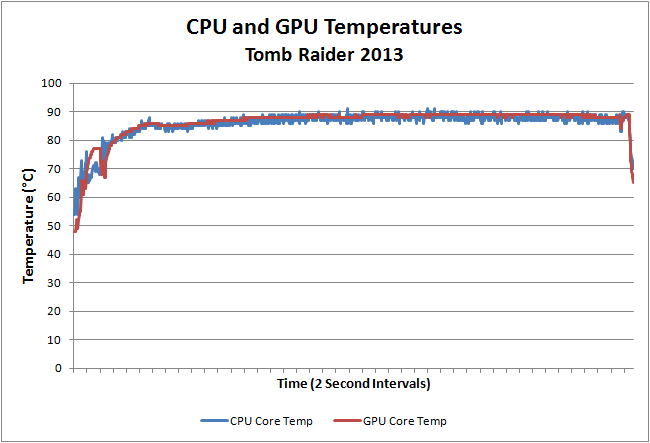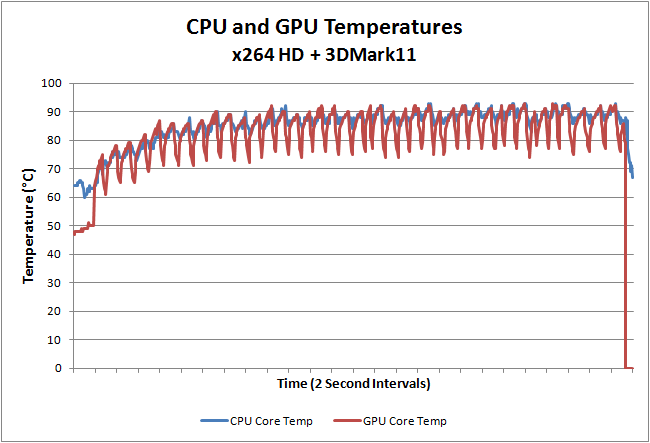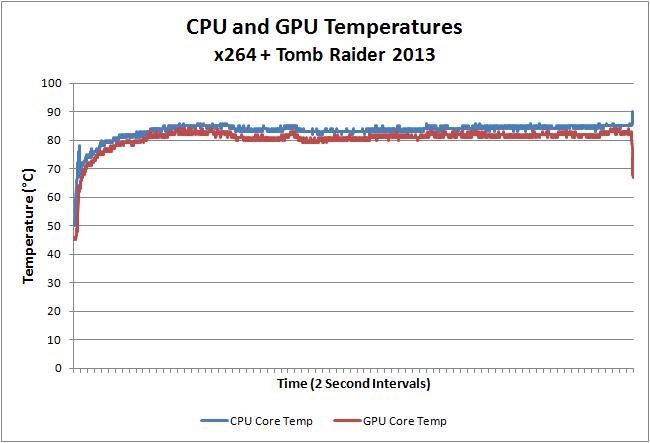Acer V7-482PG-9884 Review: Everything You Need
by Jarred Walton on August 24, 2013 12:00 AM ESTTemperatures
What happens to a slim, reasonably light, and reasonably powerful laptop when you put a sustained heavy load on the CPU and GPU? This is an area where we’ve seen quite a few laptops fall short; either they throttle CPU and/or GPU performance to cope with the heat (e.g. Dell’s XPS 15), or they get really hot – sometimes both! Logging CPU and GPU temperatures (and clock speeds) while the Aspire V7 runs a game (Tomb Raider), we get the following chart. (Note that the measurements are sampled at two second intervals, but the distance between hash marks on the x-axis is closer to one minute.)

Under most common gaming loads, in a matter of 10-15 minutes the V7 will reach the point where temperatures and clocks stabilize. In this case, the CPU and GPU temperatures are typically just under 90C, though the CPU did peak at 91C. That isn’t spectacular but it’s actually not too bad compared to other Ultrabooks that we’ve tested – Ultrabooks that didn’t have a dGPU. As far as clock speeds are concerned, the GPU stayed at a steady 1162.7MHz core/1800MHz RAM throughout the testing, so there’s no throttling on that part. Meanwhile, the CPU started at 2700-3000MHz (maximum Turbo Boost was achieved), and after a few minutes it settled into a comfortable 2400-2500MHz. (On a related note, stress testing with OCCT on the GPU caused the GPU to throttle down to a 758MHz core clock, so it was actually less strenuous than running a game like Tomb Raider.)

For our next stress test, we ran the x264 HD 5.0 encode on one CPU core (two threads) and 3DMark11 looping the four graphics tests on the GPU. This isn’t necessarily a worst-case stress test, but it’s the sort of load that we expect any well-designed system to handle without CPU temperatures breaking 95C (and preferably staying under 85C). The V7 does manage to stay under 95C, but just barely; we see temperatures of 93C on the CPU and 92C on the GPU within 10 minutes of launching our stress test, at which point the system basically enters steady-state – the GPU cools off a bit during scene transitions (analogous to level loads), and the CPU clock speeds range between 2100 MHz and 2700 MHz. So again the CPU isn’t running at maximum Turbo speed the whole time, but it does stay above the minimum guaranteed 1.8 GHz.

As a final stress test, the above is a plot of temperatures while running x264 HD with Tomb Raider – there’s no loading of levels this time, so the GPU is under a continuous load. The result is actually less demanding than the above stress test, at least in terms of temperatures, so apparently 3DMark11 manages to hit the GPU harder than Tomb Raider. Without the breaks between 3DMark11 scenes we don’t see any cyclical cooling down of the CPU and GPU, but the CPU clocks settle down at 2000-2100MHz this time while the GPU stays at the same 1163/1800MHz. The maximum temperature of the CPU this time is 87C – it actually gets hotter without the load on the GPU. The GT 750M meanwhile tops out at 84C.
I discussed overclocking of the GPU RAM a couple pages back, and you might be wondering what that does to the core temperatures. The answer: surprisingly little. I logged temperatures and clock speeds while running through our entire gaming suite, with very little idle time in between benchmarks. Throughout the entire set of benchmarks, the maximum CPU temperature was 87C and the maximum GPU temperature was 88C. I'd expect maybe a couple of degrees more than running at stock clocks, but GPU Boost may back off a little at times due to the increased power/heat from the GPU RAM, resulting in pretty much no significant change.
In the end, while we’d be happier with lower temperatures than what we’re seeing, the V7 still manages to deliver very good performance in a compelling form factor. The dual cooling fans with shared heatpipes appear to cope with the heat levels well enough for sustained use, though I’d recommend keeping the laptop on a desk or other flat surface when gaming or doing other computationally intensive work as the bottom of the V7 gets fairly toasty under load (mostly in the back-center area). Having the V7 on your lap will also tend to block the air intakes that are located on the bottom, right where the laptop would be resting on your thighs. It's not a problem for casual use, but under load it's pretty warm.
Noise Levels
There’s generally a close relationship between temperatures and noise levels; some laptops spin their fans faster and generate more noise in order to keep temperatures down, while others let the CPU and GPU get a little warmer in the hopes of reducing noise levels. The Acer V7 is better than most laptops in that maximum noise output during stress testing and gaming is 38.3dB, while at idle the laptop is generally silent (or at least below the 30dB noise floor of my equipment and location). The use of two apparently lower RPM fans instead of a single fan helps here as well.
I did cover both of the vents while running Tomb Raider to see if I could trigger a higher fan speed, but I was unable to do so – for better or worse, the fans appear to be maxed out at 38dB. Even temperatures weren’t any worse with covered vents; instead, the GPU clocks dropped slightly to 967MHz, which apparently was enough to keep the system below 90C. If you happen to be in a hotter environment (like Brian in Arizona during the summer), the V7 may run a bit slower to deal with the added heat, but it’s not a major concern. For reference, my testing location in Washington ranged from 60-90F (15-32C), so while a 50C ambient temperature would be far less accommodating, I can’t say that shag carpet with a towel covering the exhausts is any better suited for running games on a laptop.










62 Comments
View All Comments
JarredWalton - Saturday, August 24, 2013 - link
Build quality is an unknown, as is battery life and some other factors, but the bigger issue is that you just can't get it yet, at least in the US. I need to ping Gigabyte and see what's up, as the only place I can find it in the US says, "This product is not available and cannot be purchased. It has been discontinued by the manufacturer or vendor." But it might simply be in the pre-release phase.GrammarNietzsche - Saturday, August 24, 2013 - link
The "major flaw" with the P34G seems to be its TN panel. source: http://www.expertreviews.co.uk/laptops/1300168/gig...You can also see the color shift on YouTube videos of the P34G.
davejake - Saturday, August 24, 2013 - link
The Gigabyte specs page claims it to be 1080p AHVA (~IPS)http://www.gigabyte.com/products/product-page.aspx...
This might be another obnoxious case of the various country models being different.
Also, thanks Jarred for the response. The "Gigabyte NB" facebook page keeps talking about early september availability for the p34g-- later for the the p35k-- but I'm trying to not hold my breath.
Samunosuke - Saturday, August 24, 2013 - link
Been looking forward to this review ever since you mentioned it was coming, in your R7 review. I believe this particular SKU is seriously overpriced. The model available on the US ncix website comes with an i5-4200U, GT 750m 4GB,same 1080p IPS touchscreen and 500GB + 24GB storage for $899. To me this is a far better value proposition than the $1300 model. The i5 might be a bottleneck in some games but its not going to be too different from the i7.Comparing this to the Asus N550 and I feel that the N550JV-DB72T is a far better deal with an i7-4700HQ, same GT 750m (2GB), 1080p IPS touchscreen,all aluminum body, max 16GB RAM and 3 USB 3.0 ports. Although the Acer has an msata slot for ssd's, the Asus has an optical drive where the mechanical drive can be put while a 2.5" ssd occupies the main HDD slot. Weight and thickness favour the Acer but I'm willing to accept that. The Acer is $1066 for the touchscreen version and $969 for the matte non touch. Absolute no brainer.
JarredWalton - Saturday, August 24, 2013 - link
The ASUS N550 does weigh about 1.5 pounds more, let's not forget that, and it looks like the same basic design as the N56JV, which was good but still rather bulky, with more plastic in the chassis. If you're after something with higher performance than the V7, there are many options out there; if you want what is basically a gaming Ultrabook that can handle any moderate task you might throw at it, I think the V7-482PG strikes a nice balance. I would like to have the option for a 1080p matte non-touch if it could save $150, but sadly there isn't one.Funny enough, the NCIX version of the V7 is apparently a Canadian model (http://store.acer.com/store/acerna/en_CA/pd/ThemeI... This is one of the frustrating things with Acer, ASUS, and a lot of other OEMs: they have good SKUs that are only released in specific markets, and often I can't figure out why. I've never tried ordering from NCIX before, but for $899 (though it's backordered), the V7-482PG-6662 is basically giving you a slower CPU, smaller HDD and less RAM for $400 less. Of course, that's a "street price" and I suspect the 9884 street prices might end up in the $1100-$1200 range, making it a more reasonable upgrade.
GrammarNietzsche - Saturday, August 24, 2013 - link
The 9884 is available on the US NCIX site as well. I couldn't link it in this comment, so you'll have to remove the (dot)http://us.ncix(dot)com/products/?sku=83180&vpn...
JBaich - Saturday, August 24, 2013 - link
Congrats to Acer for reversing course on the "race to the bottom". RTTBSadly, it might be another 10 years for me before the name Acer doesn't resonate with garbage. They will, and should, suffer for a build-em-and-sell-em-cheap strategy. I'm not convinced.
Anonymous1a - Saturday, August 24, 2013 - link
I was wondering, given that the processor, despite being an i7, is still a ULT processor, and not even a quad-core, will this not be a limiting factor to the graphics card and will this laptop be able to render graphically challenging games?JarredWalton - Saturday, August 24, 2013 - link
The majority of games still don't really need more than one or two CPU cores, and with Turbo Boost you're still able to hit 2.7-3.0GHz on the i7-4500U. With a faster GPU it would be more of a bottleneck, but the GT 750M is clearly tapped out in most titles already, at least at our Mainstream settings. (You'll notice that overclocking the GPU RAM didn't help on the Value settings, but that could be more the GPU core not needing more RAM than a CPU bottleneck; I'd have to investigate more to say for certain.) I think a GTX 765M would probably be where we see the shift to being CPU bound with a ULT processor, but even then you can usually get >40FPS from the CPU if the GPU can manage, so you can turn up details to compensate if you had a faster GPU.This is where the MSI GX60 runs into problems with some games, as single-threaded performance of the A10 APUs is still significantly slower than even the ULV/ULT parts. It's pretty sad that an Ultrabook with a much slower GPU can outperform it in several of the games, even at Mainstream detail.
just2btecky - Saturday, August 24, 2013 - link
Acer Aspire V7-482PG-9884 has a funky name I'll never remember. I aspire:) for a name that's really cute.